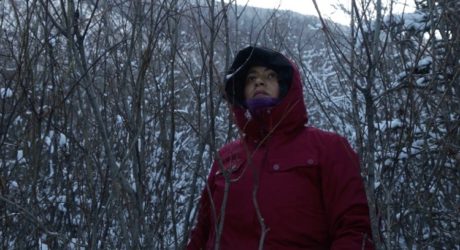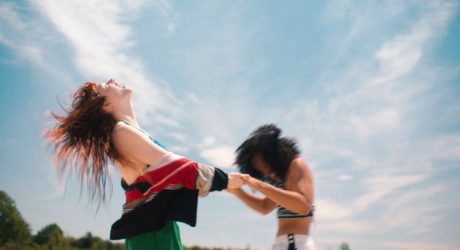
Fictional characters, as with the people we encounter in our own lives, morph over time in the annals of our memory. They become, like most things, a reflection of our relationship to them. This is the paradox central to French filmmaker Aminatou Echard’s 2017 documentary Djamilia, which explores the relationship that women in contemporary Kyrgyzstan have to the title character of Chinghiz Aitmatov’s eponymous 1958 novel.
cléo spoke with Aminatou about the film in anticipation of its screening at the 31st Images Festival in Toronto.
Your documentary, Djamilia, which premiered at Berlinale this year, explores the relationship that women in contemporary Kyrgyzstan have to the title character of Chinghiz Aitmatov’s 1958 novel — a local literary heroine and emblem of women’s empowerment in the country. When did you first come across Aitmatov’s novel, and what made you decide to tell this story?
Before going to Kyrgyzstan for the first time in 2006, a friend gave me a copy of Djamilia. I didn’t read it until I came back [to France], and the book was magnificent — it touched me right away. I introduced the character of Djamilia in the first film that I shot in Kyrgyzstan (Broadway, 2011). During the filming, I was looking for an actress to play Djamilia and one day, after I had been in a bazaar for a week helping some artist friends who were doing a residence there, I started to spread the word that I was looking for “a Djamilia.” I then started to meet with women who came to find me, as they wanted to play her. Some of the women were very young (15-20 years old), but others were much further along in life and already grandmothers. They all spoke to me with such vitality in their eyes, and so freely, of Djamilia. I was surprised to see older women show interest in playing Djamilia (she is 20 in the book), but some told me: “Yes, I’m older, but as you can see, I’m a Djamilia!”
One by one, as the women talked to me, I knew a film would be born out of [their] encounters with the fictional character. This was the genesis of the film [in 2009]. But it’s not just the relationship the women have with Djamilia that’s in the film; it’s about more than the fictional character. Djamilia was a means to start conversations that allowed me to speak with women about their lives, their views of the world. Djamilia allowed me to explore an idea, and the women’s ideas.
The film was shot on Super 8, and the visuals were then paired with audio from your interviews with Kyrgyz women. What inspired this approach?
I shot on Super 8, which is silent. I had to record the sound separately. Because of this, I worked on the film and sound edits from the beginning with my editor, Gil Savoy. We had four sessions to work on the sound over the entire edit. I felt it was essential to work this way, so that image and sound existed separately but would create a new meaning together when they met. The soundtrack was composed of ambient noises, music, whispering, women’s voices, silence.
This attachment I have to exploring the connection between sound and image drew me to work with Super 8, because with this film stock you can play with each of these elements. This is more difficult with video, which synchronizes sound. Filming on Super 8 may have had some limitations, but it gave me great freedom in the edit to ask questions about the medium of cinema.
Of course, Super 8 is also beautiful, with its warm colour and texture; I place great importance on the quality of the image. But this wasn’t the only reason to shoot on Super 8. To broaden the question a bit, in the end, I decided: “I’ll film on a small Super 8 camera, which will allow me some mobility while on location.” I didn’t have many reels, as it’s expensive, so I couldn’t shoot a lot. I only had 80 reels of 2’30” for all of Djamilia, which works out to about 3 hours and 45 minutes of footage. This placed a constraint on the shoot. I couldn’t make a mistake, I needed to know what I wanted to film. I was always under pressure and this bled into the desire to film.
Over the course of meeting with the women, I managed to establish a relationship that wasn’t that of “a nightly news journalist,” which is typically seen in the media. My interpreter explained [to the women] how precious the Super 8 film was. Because I wasn’t filming I could live in the moment, and be intensely present and share. After the conversation [between the interpreter and the women about the film stock], when it was time to film these women they knew the plan and that we only had one reel, and they understood the importance of the take — and they accepted this “game,” which was a beautiful and intense gift.
Super 8 introduced a specific kind of presence during the shoot and on several levels of filmmaking.
Your CV shows extensive study in both documentary and ethnomusicology. In what ways has your scholarship on the latter informed your practice of the former?
I finished my studies a long time ago now. All the experiences that I’ve lived — all my chance encounters — have influenced my style of working, the roads I’ve taken, and my practice. Happily, this is still being nourished and is evolving.
It’s essential to me to take time in the places where I’m filming and with the people there, to get to know their interiorities and to better understand and convey their universe, and the universes I encounter, through cinema, which is my mode of expression. It’s not about thinking we can know everything, or understand everything. What I can do is absorb this reality, try to look deeper, try to understand it by being there, by meeting people, by building relationships.
It’s not about learning things, but feeling things. We can understand a lot without speaking or being in a position where we need to ask questions. Rather, we can be in a place where we are simply present, sharing moments, conversations. It’s not just about being an outside observer, it’s about accepting, and giving.
Time is then really essential, as it’s usually just when we have the impression that there’s nothing left to see or hear that we really begin to see and hear. From my anthropology studies, I took my passion for being in the field and an attention to detail. Ethnomusicology taught me something else: to think that everything is music. It taught me to not put a hierarchy between sources of sound.
Thus, on a shoot I look, I listen, I film, I record. For Djamilia, leaving aside for a moment the importance of the conversations themselves, it was also key for me to work with the voice’s musical quality — to highlight each voice’s intonations, rhythms, melodies, almost as if they were singing. So, beyond my now long-past studies, these are the ways of seeing and thinking that, bit by bit, have become part of my way of being and filming.
This text has been edited and condensed for length. Translation from French to English by Kiva Reardon.
Originally published April 19, 2018





